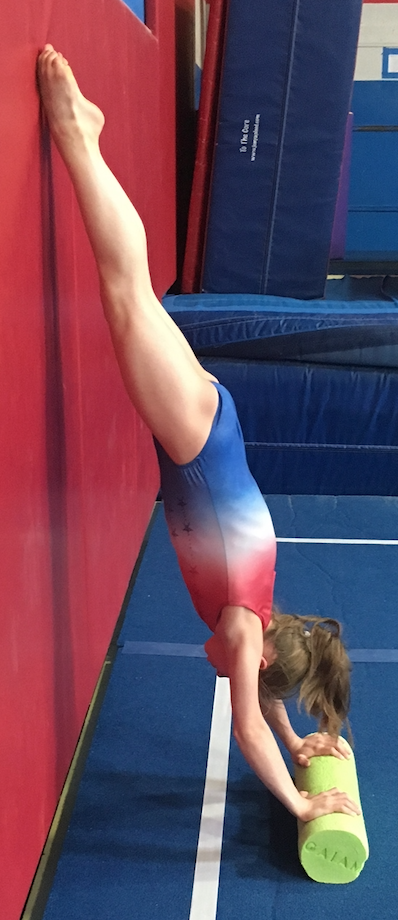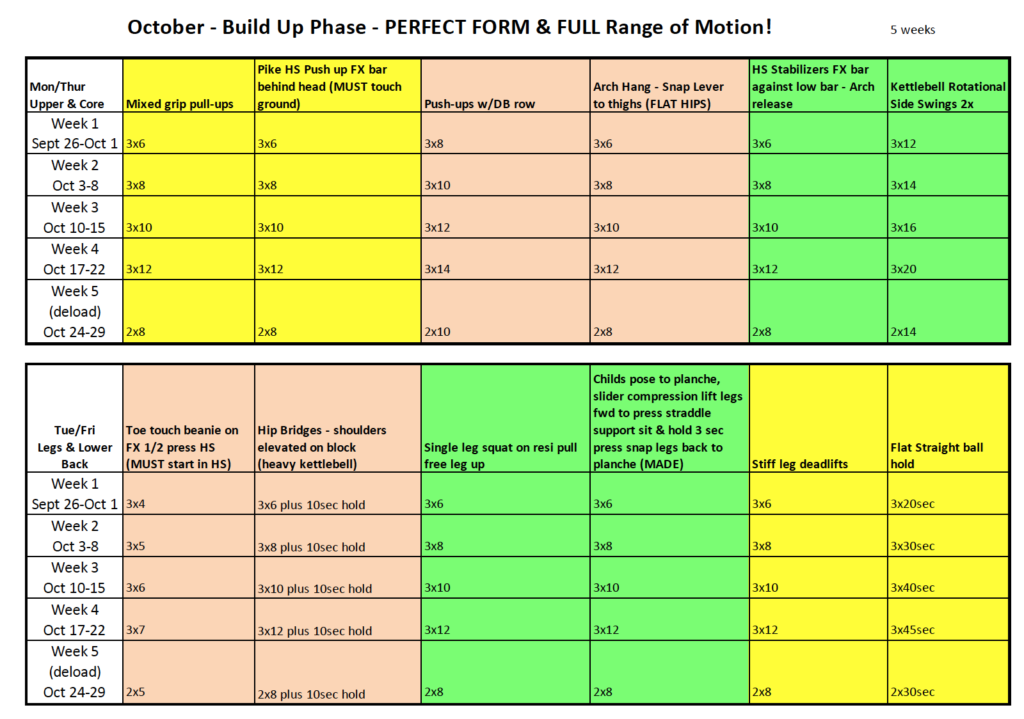
How to create an annual periodized strength and conditioning program.
As the saying goes, failing to plan is planning to fail. So let’s make sure we take the first step and start the annual strength and conditioning plan.
Annual Conditioning Timeline
When planning for conditioning in gymnastics we need to break our workouts into macro and micro cycles starting with your final competition and working backwards to find your starting point of the macro cycle. The annual periodized conditioning plan will last 30-34 weeks with another 4 weeks of physical therapy-based conditioning for a total of 34-38 weeks. We set our timeline from Level 10 Nationals and count backwards 30-34 weeks to find our starting week. Then in June we use our 4 weeks of physical therapy conditioning.

Here is Flips Gymnastics Annual Strength and Conditioning Plan for the 2022-2023 competitive season. This plan lasts 33 weeks ending with level 10 nationals on the weekend of May 13th.
How to Read the Annual Plan
The top line of this plan is the numbered weeks, the 2nd line is the months, 3rd line is Saturday’s date at each week’s end, and the 4th line is the training phases. Written in at the bottom is the number of weeks to each phase.
Phases of Conditioning in Gymnastics
Each phase of this strength and conditioning program has different set and rep schemes to change the volume of training based on each phase. Along with that we need to make sure that we are conditioning all the movements of gymnastics and add additional exercises to properly balance the entire athlete. As we know with any type of sports specific training, that specificity builds weaknesses in other areas. This must be considered when designing your strength and conditioning program to build balanced athletes.
Side note: When reading the phases below know that there are some “gymnastics type” specific conditioning that cannot be done in the higher rep ranges so it may not follow the suggested numbers.
General Strength Phase
The general strength phase uses reps from 8-15 and sets of 2-3. Most of this phase we are using sets of 2 in our programming.
Build-up Phase
The purpose of the build-up phase is to build base strength and muscle to handle the load of gymnastics. This phase runs a set and rep range of 2-3 sets of 10-15 reps and last 9 weeks.
Max Strength Phase
Maximum strength phase is just that, develop max strength. This phase will stay in the strength rep range of 5-10 reps with again 2-3 sets. We add weights and resistance in this phase. This phase lasts 4-6 weeks based off your timeline.
Power Phase
The power phase is a sub phase of max strength when we are focusing on developing as much power as possible for gymnastics. This phase is from 2-3 sets and uses our lowest rep range of 3-8 lasting 3-4 weeks.
Conversion Phase
The conversion phase is similar in sets and reps as the build-up phase of 2-3 sets of 10-15 reps and runs for 6 weeks.
Maintenance Phase
In the maintenance phase we are focused on keeping our athletes at their peak gymnastics’ specific strength without the breakdown of muscle. We run the set range from 1-2 and the reps in the 6-10 range lasting up to 6 weeks. You do not have to use all 6 weeks of this phase; you can be at your end of season competition 2-3 weeks into this phase if you choose.
Physical Therapy Conditioning
This 4-week phase uses all physical therapy-based exercises for 2-3 sets for 10-20 reps.
Movements for your Gymnastics Strength and Conditioning Program
The 7 Movements of Gymnastics (from Dr. Bill Sands article)
These 7 movements of gymnastics need to be equally covered in your conditioning for gymnastics.
- Shoulder Flexion – Casting, Press handstands, Planche
- Shoulder Extension – Kipping, Uprise, Downswing phase on bars
- Upper Extremity Pushing – Handstand, Handstand push-ups, Rebounding off hands
- Upper Extremity Pulling – Pull-up, Pull-up pullover, Bottom of swing on bars
- Jumping and Landing
- Torso and Hip Flexion – Hollow, Leg lifts, Tucking or piking
- Torso and Hip Extension – Arch, Back tumble takeoffs
Balanced Upper and Lower Body Programming
There are 10 movements in a balanced strength and conditioning program: 5 upper body and 5 lower body movements.
Upper Body Movements
- Horizontal push – push-ups, bench press
- Horizontal pull – horizontal row, bent rows
- Vertical push – handstand push-up, overhead press
- Vertical pull – pull-up, rope climb, lat pulldowns
- Unilateral work – right and left balance – (multi-plane exercises)
5 Lower Body Movements
- Hip Dominant Push – Hip lifts, swing
- Hip Dominant Pull – Deadlift
- Knee Dominant Push – Squats, lunges
- Knee Dominant Pull – Hamstring curls, tree falls
- Unilateral work – right and left balance
Build your Gymnastics Conditioning Workout
Before we build your gymnastics conditioning workouts, we must use a combination of the 7 movements of gymnastics and the 10 movements to building a balanced athlete. These will need to be prioritized by your facility, equipment, allotted time to condition, etc.
Here is an example of our October 2022 Week 1 through 5 of the Build-up Phase. This should be completed in 20 minutes; the color coding shows exercises to superset. We perform this conditioning after a 10-minute active running warm-up. We also have another 30 minutes at the end of practice for 15 minutes of conditioning and 15 minutes of active flexibility.
You can see that we condition this program 4x a week, repeating exercises on Monday/Thursday and Tuesday/Friday. It is a linear progressive program adding reps each week. If the program runs for more than 4 weeks of the same exercises the 5th week will be a deload week matching the rep scheme of week 2. (We also have different core circuits and high intensity interval leg circuits we condition 2x week towards the end of practice.)

What is covered in this October conditioning plan.
- Shoulder Flexion & Vertical Push
- Shoulder Extension
- Upper Extremity Pushing
- Upper Extremity Pulling & Vertical pull
- Torso and Hip Extension
- Horizontal push
- Horizontal pull
- Upper Unilateral work
- Hip Dominant Push
- Hip Dominant Pull & Knee Dominant Pull
- Knee Dominant Push
What is left out of this October conditioning plan.
There are 3 movements left out of this strength and conditioning plan on purpose. These we make sure are covered in our 15 minutes of conditioning towards the end of practice. We use high intensity interval leg circuits on Monday/Thursday (opposite of the leg conditioning days) and Core/Active Shoulder circuits Tuesday/Thursday.
- Jumping and Landing
- Torso and Hip Flexion
- Lower Unilateral work
Conclusion for Conditioning in Gymnastics – How to Create an Annual Periodized Strength and Conditioning Plan
If you have never made an annual conditioning plan, then the most important part about creating an annual plan is sitting down and getting it done. This is the first step to a successful strength and conditioning program for gymnastics. You don’t need to write the monthly details yet, just get the annual plan done as soon as possible with the numbered weeks, the Months, the Saturdays for each week’s end, and the training phases.
Good luck on your annual strength and conditioning plan!
Other events from How To Gymnastics:
Warning: The reader of this article should exercise all precautions before following any of the exercises from this article and website. To avoid any problems while doing the exercises, it is advised that you consult a medical professional and are supervised by a gymnastics professional. The responsibility lies solely with the reader and not with the site or the writers. This post can may contain affiliate links meaning if you buy something we get a small commission at no extra cost to you.